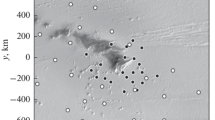Abstract
Experimental results of the seismic profiling with bottom penetration up to 1000 m based on broadband signals and conducted in the Caspian Sea sites are presented. Use has been made of synchronized sequences of probing pulses with linear frequency modulation at a frequency deviation of 50 to100 Hz. The pulses were emitted by a towed sound source of an original design (acoustic power up to 300 W, frequency ranged from 100 to 1000 Hz) and received by a standard digital seismic streamer. The processing of the signals involved the matched filtering of the individual pulses and the trajectory accumulation of a long sequence of pulses lengthwise the horizontal-homogeneous reflecting layers of the bottom structure. The adaptive stacking procedure taking into account the linear inclinations of the individual layers allowed us to enlarge the stacking interval by up to 100 pulses and to increase the effective depth and the spatial resolution of the seismic profiling, which gave us a total increase of more than 30 dB in the S/N ratio. In our view, the seismic profiling using low-power (about 100 W) and broadband (up to several hundred Hz) coherent sound sources represents a promising technology for decreasing the hazardous impact on aquatic ecosystems. The approach developed is an alternative to the conventional technology of marine seismic prospecting based on powerful pulse sources of the shock type (air guns, sparkers) in the low frequency range (less than ∼200 Hz).
Similar content being viewed by others
References
V. S. Averbakh, V. V. Artel’nyi, B. N. Bogolyubov, et al., “Prospective methods and technical tools for acoustic sounding of a shelf and coastal zone of ocean,” in Fundamental Studies of the Oceans and Seas (Nauka, Moscow, 2006), Vol. 2, pp. 491–511.
V. G. Gaynanov and A. S. Zverev, “An acoustic complex for dual-frequency profiling of aquatic areas,” Oceanology (Engl. Transl.) 50(4), 613–617 (2010).
V. A. Lazarev, I. I. Leonov, V. B. Bystranov, et al., “Measurement of timing coherence of field of low-frequency hydroacoustic oscillator,” in Reports of Acoustic Scientific Session, Nizhnii Novgorod (Gos. Univ. im. N. I. Lobachevskogo, Nizhnii Novgorod, 2005), pp. 247–248.
L. R. Merklin, “General technological methods used in marine seismologic exploration,” in Proc. XIII School-Seminar of Academician L. M. Brekhovskikh “Acoustics of an Ocean”, associated with XXIII Session of Russian Acoustic Society (GEOS, Moscow, 2002), pp. 351–358.
L. R. Merklin and O. V. Levchenko, “Acoustic studies with parametric profilograph (1988–2001),” in Acoustic Oceanologic Studies and Expeditions, Ed. by V. P. Kuznetsov, et al. (Rostizdat, Rostov-on-Don, 2002), pp. 396–413.
L. R. Merklin and V. A. Putans, “Acoustic abnormalities determined in bottom deposits of the Caspian Sea,” in Trans. XXIV Session of Russian Acoustic Society and Session of Scientific Committee on Acoustics, Russian Academy of Sciences (GEOS, Moscow, 2011), pp. 250–258.
V. I. Romanova, L. R. Merklin, A. I. Khil’ko, et al., “Experimental studies of efficiency of acoustic measurements of marine bottom depending on spectral and statistical characteristics of noises and statics,” in Trans. XXII Session of Russian Acoustic Society and Session of Scientific Committee on Acoustics, Russian Academy of Sciences (GEOS, Moscow, 2010), pp. 301–305.
N. A. Sidorovskaya, G. E. Ioup, D. V. Ioup, et al., “Implementation of passive acoustic methods to study of the influence of industrial impact on marine megafauna,” in Proc. XIII School-Seminar of Academician L. M. Brekhovskikh “Acoustic of the Ocean”, Associated with XXIII Session of Russian Acoustic Society (GEOS, Moscow, 2011), pp. 205–211.
B. Askeland, B. O. Ruud, H. Hobak, and R. Mjelde, “A seismic field test with a low-level acoustic combustion source and pseudo-noise codes,” J. Appl. Geophys. 22(9), 1224–1236 (2008).
Y. Jiang, N. R. Chapman, and H. A. de Ferrari, “Geoacoustic inversion of broadband data by matched beam processing,” J. Acoust. Soc. Am. 119(6), 3707–3716 (2006).
A. M. Tashmukhambetov, G. E. Ioup, J. W. Ioup, et al., “Three-dimension seismic array characterization study: Experiment and modeling,” J. Acoust. Soc. Am. 123(6), 4094–4108 (2008).
T. C. Yang, K. Yoo, and P. Fialkowski, “Subbottom profiling using a ship towed line array and geoacoustic inversion,” J. Acoust. Soc. Am. 122(6), 3338–3352 (2007).
Author information
Authors and Affiliations
Corresponding author
Additional information
Original Russian Text © V.A. Lazarev, A.I. Malekhanov, L.R. Merklin, V.I. Romanova, V.I. Talanov, A.I. Khil’ko, 2013, published in Okeanologiya, 2013, Vol. 53, No. 6, pp. 843–850.
Rights and permissions
About this article
Cite this article
Lazarev, V.A., Malekhanov, A.I., Merklin, L.R. et al. Coherent seismic sea-bottom profiling based on broadband signals. Oceanology 53, 755–761 (2013). https://doi.org/10.1134/S000143701305007X
Received:
Accepted:
Published:
Issue Date:
DOI: https://doi.org/10.1134/S000143701305007X



